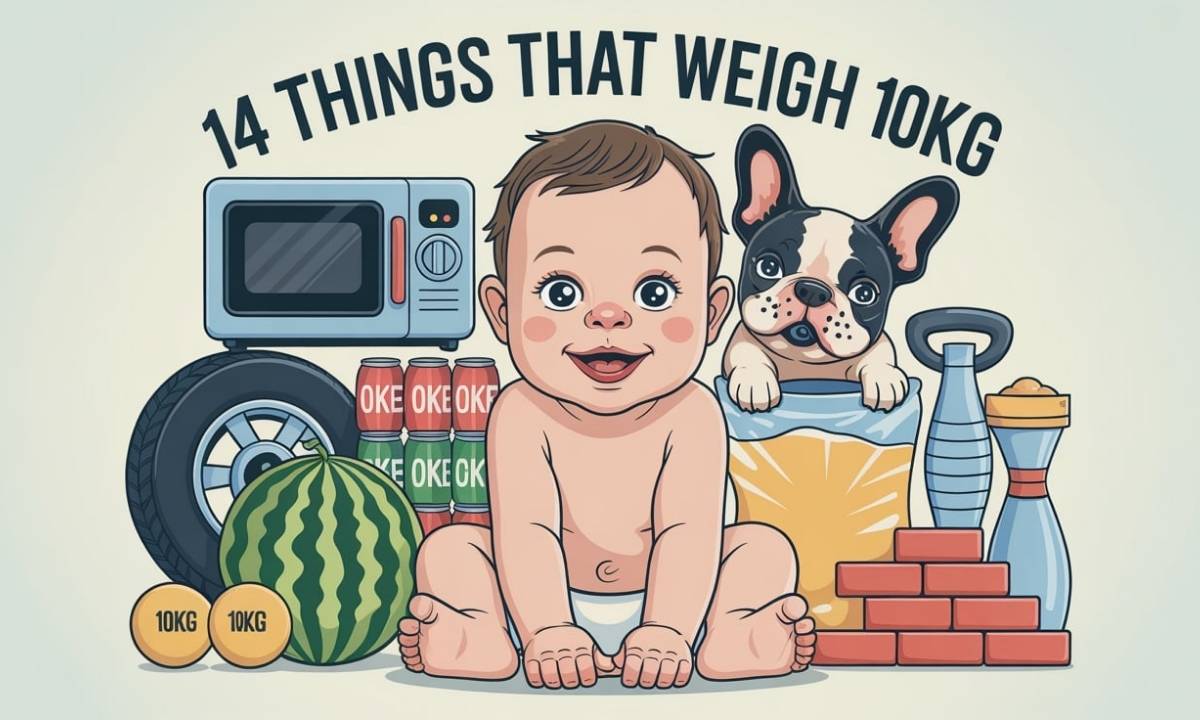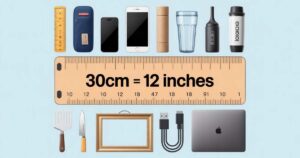Ever grabbed a toddler and wondered exactly how heavy they feel? You’re experiencing roughly 10 kilograms of weight. This measurement appears everywhere in daily life, yet most Americans struggle to visualize what ten kg actually means.
Whether you’re planning a move, hitting the gym, or simply satisfying curiosity, understanding 10 kg weight helps you navigate countless situations. From checking luggage limits to choosing workout equipment, this knowledge proves surprisingly practical.
We’ll explore 14 everyday items that hit this exact measurement. Some will surprise you. Others might become your go-to reference points when explaining kilogram weight to friends and family.
How Heavy is 10 Kg?
Converting 10 kilograms to familiar measurements reveals its true impact. This weight equals 22.05 pounds – heavier than most people initially guess.
Picture lifting a medium-sized dog or carrying two full gallons of milk simultaneously. That strain you feel? That’s 10 kg mass working against your muscles.
Weight Comparison Table
| Measurement | 10 Kg Equivalent |
| Pounds | 22.05 lbs |
| Ounces | 352.74 oz |
| Stones | 1.57 stones |
| Newtons | 98.07 N |
Context matters tremendously. Lifting 10 kilos overhead challenges most people. Carrying this weight in a backpack feels manageable for short distances. Deadlifting it seems almost laughably light for experienced gym-goers.
Airlines often use this benchmark too. Many carriers limit carry-on bags to exactly 10 kg weight. International shipping companies frequently charge premium rates beyond this threshold.
Your body experiences 10 kilograms differently based on leverage and position. Holding weight close to your torso feels easier than extending it away from your body. Physics explains why that seemingly light bag becomes unbearable when carried at arm’s length.
Things That Weigh 10 Kgs
The following common items demonstrate this weight across various categories. From kitchen staples to gym equipment, these examples span different aspects of modern life.
Each item offers unique context for understanding 10 kg mass. Some you’ll encounter daily. Others might surprise you with their precise measurement.
1. A Ten-Kilogram Dumbbell

The most obvious example remains the dumbbell 10 kilograms. This weightlifting gear serves as the perfect baseline for understanding this measurement.
Fitness dumbbells come in various materials affecting their feel:
- Cast iron versions feel compact and dense
- Rubber-coated options provide better grip
- Adjustable dumbbells offer versatility
- Chrome finishes resist rust but show fingerprints
Most gyms stock 10 kg dumbbells as intermediate workout weights. Beginners often graduate to this weight after mastering lighter options. Advanced lifters use them for isolation exercises or high-repetition training.
Professional trainers recommend starting bicep curls with 5kg weights before progressing to exercise equipment weighing 10 kilograms. This progression prevents injury while building strength steadily.
The compact size surprises newcomers. Ten kg concentrates into a surprisingly small package, demonstrating how dense muscle-building materials can be.
2. Ten Liters of Water

Water provides the perfect liquid weight reference because one liter equals exactly one kilogram. Therefore, ten liters of water weighs precisely 10 kilograms.
This water measurement appears in numerous practical scenarios:
- Emergency preparedness kits
- Camping supply calculations
- Aquarium setup planning
- Garden irrigation systems
- Household storage containers
Water Usage Facts
| Activity | Water Amount | Time Required |
| Average shower | 10 liters | 2-3 minutes |
| Toilet flush | 10 liters | 1-2 flushes |
| Dishwasher cycle | 10 liters | Full load |
| Hand car wash | 10 liters | Rinse phase |
Environmental context makes this measurement meaningful. The average American uses 300 liters daily. Our 10L water example represents just over 3% of typical consumption.
Storage considerations become important at this volume. Water containers holding ten liters require sturdy handles and balanced design. Most people can’t comfortably carry this much liquid weight for extended periods.
Survival experts recommend storing exactly this amount per person for three-day emergency kits. The weight-to-necessity ratio makes ten liters of water optimal for emergency preparedness.
3. Small Countertop Microwave

Modern kitchen microwaves in the compact category typically weigh 10 kilograms. These portable microwaves balance functionality with space efficiency.
Household microwaves at this weight usually offer:
- 0.7 to 1.1 cubic feet capacity
- 700-1000 watts of cooking power
- Digital controls and preset functions
- Turntable for even heating
- Compact footprint for small kitchens
Popular models hitting this exact weight include:
- Panasonic NN-SB438S
- Toshiba EM925A5A-SS
- BLACK+DECKER EM720CB7
- Hamilton Beach 0.7 cu ft
The small countertop microwave weight reflects internal components. Magnetron assemblies, transformers, and metal shielding contribute significantly to overall mass.
Moving considerations become relevant at this weight. While manageable for most adults, compact appliances weighing 10 kg require careful handling during kitchen renovations or apartment moves.
Installation tips for microwave ovens this heavy:
- Ensure countertop support adequacy
- Allow proper ventilation clearance
- Use appliance dollies for transport
- Consider cabinet mounting brackets for permanent installation
4. Ten Kg Bag of Flour

Commercial flour sacks commonly come in 10 kg sizes, especially for serious home bakers or small businesses. This bulk flour quantity provides excellent value while remaining manageable.
Baking supply math becomes interesting at this scale:
- Approximately 80 cups of all-purpose flour
- Enough for 15-20 standard loaves of bread
- Base ingredient for 200+ cookies
- Foundation for multiple pizza dough batches
Flour Types and Density
| Flour Type | Density (g/cup) | Cups per 10kg |
| All-purpose | 125g | 80 cups |
| Bread flour | 130g | 77 cups |
| Cake flour | 115g | 87 cups |
| Whole wheat | 135g | 74 cups |
Professional bakers routinely handle cooking ingredients at this scale. Home enthusiasts often discover that 10 kg bag of flour lasts surprisingly long, even with regular baking.
Storage challenges emerge with this quantity. Proper containers prevent pest infiltration and moisture absorption. Many bakers divide the kitchen staple into smaller, manageable portions immediately after purchase.
Cost analysis reveals significant savings. Buying flour sacks in 10 kilogram quantities typically costs 40-60% less per pound than smaller packages. The math strongly favors bulk purchasing for regular bakers.
5. Four Average-Size Bricks

Standard construction bricks weigh approximately 2.5 kilograms each. Therefore, four bricks equal exactly 10 kilograms.
Building materials at this scale serve various purposes:
- Garden border creation
- Outdoor fire pit construction
- Temporary weight anchors
- Exercise equipment alternatives
- Decorative landscape elements
Brick Specifications
| Measurement | Standard Brick |
| Length | 215mm (8.5″) |
| Width | 102.5mm (4″) |
| Height | 65mm (2.5″) |
| Weight | 2.5kg (5.5 lbs) |
| Material | Clay composite |
DIY projects often require brick weight calculations. Understanding that four average-size bricks equal 10 kg mass helps estimate material needs and transportation requirements.
Historical context reveals brick standardization evolved over centuries. Modern dimensions optimize handling while maintaining structural integrity. The 2.5kg weight per brick represents the practical limit for comfortable manual handling.
Alternative applications showcase brick versatility:
- Makeshift workout weights during gym closures
- Ballast for temporary structures
- Heat retention in outdoor cooking
- Foundation elements for small projects
6. A French Bulldog

Healthy adult French Bulldogs typically weigh between 8-12 kilograms, with many falling precisely at 10 kg. This makes Frenchie weight an excellent living reference point.
Canine weight standards for French Bulldogs:
- Males: 9-12 kg (20-28 lbs)
- Females: 8-11 kg (18-24 lbs)
- Show standard: 9-12.5 kg maximum
- Pet insurance: 10 kg average for calculations
Breed characteristics affecting weight include:
- Compact, muscular build
- Dense bone structure
- Minimal height variation
- Gender-based size differences
- Age-related weight changes
French Bulldog Weight Timeline
| Life Stage | Weight Range | Duration |
| Puppy (8 weeks) | 1-2 kg | Birth-2 months |
| Juvenile | 4-6 kg | 2-6 months |
| Adolescent | 7-9 kg | 6-12 months |
| Adult | 8-12 kg | 1+ years |
Veterinary considerations make dog weight monitoring crucial. French Bulldogs easily become overweight due to their low exercise requirements and food motivation. Regular weigh-ins help maintain optimal pet weight.
Practical implications of owning a 10 kilogram French Bulldog:
- Comfortable lap dog for most adults
- Manageable lifting for vet visits
- Moderate food and medication dosing
- Suitable for apartment living
- Travel-friendly in carriers
Handling techniques for canine weight at this level require proper form. Always support the dog’s chest and hindquarters when lifting to prevent injury to both pet and owner.
7. A 24-Pack of Coke

Standard 24-pack of Coke in 12-ounce cans weighs approximately 10 kilograms. This beverage pack represents a common grocery purchase with precise weight specifications.
Soft drink package components contributing to total weight:
- 24 aluminum cans (empty): 0.5 kg
- Coca-Cola liquid: 8.5 kg
- Cardboard packaging: 0.2 kg
- Plastic wrap: 0.1 kg
- Total: 10.0 kg
Beverage Weight Comparison
| Package Type | Quantity | Weight | Cost Efficiency |
| 12-pack cans | 12 × 355ml | 5.0 kg | Moderate |
| 24-pack cans | 24 × 355ml | 10.0 kg | Best |
| 6-pack bottles | 6 × 500ml | 4.2 kg | Poor |
| 2-liter bottles | 4 bottles | 9.2 kg | Good |
Consumer behavior studies show drink cartons at this size optimize convenience versus weight. Most adults can manage 10 kg for short distances while maximizing purchase efficiency.
Storage logistics become relevant with Coke cases weighing 10 kilograms. Refrigerator space, pantry shelving, and transportation all require consideration when buying soda packs at this scale.
Economic analysis reveals 24-packs offer the best per-unit pricing. The 10 kg weight trades convenience for significant cost savings compared to smaller package sizes.
Environmental impact calculations use beverage pack weight as a baseline. Recycling facilities process millions of these 10 kilogram packages annually, making them a significant component of municipal waste streams.
8. Two Gallons of Paint

Standard interior paint cans weigh approximately 5 kg per gallon. Therefore, two gallons of paint equal exactly 10 kilograms.
Wall paint coverage calculations become practical at this quantity:
- Interior walls: 700-800 square feet
- Primer application: 600-700 square feet
- Exterior surfaces: 500-600 square feet
- Ceiling coverage: 800-900 square feet
Paint Weight by Type
| Paint Type | Weight per Gallon | Coverage per Gallon |
| Latex interior | 4.8-5.2 kg | 350-400 sq ft |
| Oil-based | 5.0-5.4 kg | 300-350 sq ft |
| Primer | 4.6-5.0 kg | 300-400 sq ft |
| Exterior | 5.1-5.5 kg | 250-350 sq ft |
Home improvement projects routinely require paint supply calculations. Understanding that liquid paint weighs 5kg per gallon helps estimate transportation needs and storage requirements.
Professional contractors often purchase paint weight in larger quantities, but two gallons represents the sweet spot for weekend DIY projects. This amount handles most single-room applications without excess waste.
Transportation considerations make 10 kg significant. Carrying paint cans up stairs or ladders requires proper technique. Most hardware stores provide hand trucks for customer convenience when purchasing multiple gallons.
Storage best practices for liquid paint:
- Temperature-controlled environments
- Secure lid closure to prevent spills
- Elevated storage to prevent floor damage
- Inventory rotation for optimal freshness
- Safety data sheet accessibility
9. A Car Tire

Standard passenger car tires typically weigh 8-12 kilograms, with many common sizes hitting exactly 10 kg. Tire weight varies based on construction and intended application.
Automobile tire specifications affecting weight:
- Tread pattern depth and design
- Sidewall construction materials
- Internal belt composition
- Rim diameter and width
- Performance versus economy focus
Tire Weight by Size
| Tire Size | Typical Weight | Common Applications |
| 185/65R15 | 8-9 kg | Compact cars |
| 205/55R16 | 9-10 kg | Mid-size sedans |
| 225/60R16 | 10-11 kg | SUVs, crossovers |
| 235/75R15 | 11-12 kg | Light trucks |
Seasonal tire changes make tire mass practically relevant. Many drivers experience the challenge of handling 10 kilogram vehicle tires during winter-to-summer swaps.
Emergency roadside scenarios test your ability to manage wheel weight. Changing a flat tire requires lifting, positioning, and securing components weighing 10 kg or more under potentially stressful conditions.
Professional installation becomes valuable considering tire measurement challenges. Proper mounting requires specialized equipment to handle the weight safely while ensuring correct balance and alignment.
Performance implications of car tire weight:
- Unsprung weight affects handling
- Heavier tires reduce fuel efficiency
- Weight distribution impacts braking
- Rotational mass influences acceleration
- Overall vehicle dynamics change with tire selection
10. Five Dozen Pool Balls

Standard pool balls weigh approximately 170 grams each. Five dozen (60 balls) total exactly 10.2 kilograms – essentially 10 kg mass.
Billiard balls construction affects weight consistency:
- Phenolic resin composition
- Precision manufacturing tolerances
- Regulation tournament standards
- Set-to-set weight variations
- Quality control specifications
Pool Equipment Weight Distribution
| Component | Quantity | Individual Weight | Total Weight |
| Cue balls | 5 | 170g | 0.85 kg |
| Numbered balls | 55 | 170g | 9.35 kg |
| Total | 60 | – | 10.2 kg |
Game room setup considerations include sports equipment weight for table stress calculations. Pool tables must support not just ball weight but also player pressure and cue impact forces.
Tournament regulations specify exact billiard ball weight requirements. Professional game balls undergo rigorous testing to ensure consistency within 0.5-gram tolerances.
Storage solutions for 60 pool balls require sturdy containers. Many enthusiasts use custom cases designed specifically for pool accessories at this quantity and weight.
Cost analysis reveals five dozen balls represent significant investment. Quality cue balls and numbered sets cost $200-500, making proper storage and maintenance crucial for longevity.
11. Two Bowling Balls

Standard bowling balls range from 6-16 pounds (2.7-7.3 kg), with 5kg bowling balls being common. Two bowling balls therefore equal approximately 10 kilograms.
Bowling ball weight selection depends on multiple factors:
- Player strength and experience
- Throwing technique preferences
- League versus recreational play
- Pin carry and power requirements
- Comfort during extended sessions
Bowling Weight Guidelines
| Player Type | Recommended Weight | Rationale |
| Beginners | 10-12 lbs (4.5-5.4 kg) | Easier control |
| Intermediate | 12-14 lbs (5.4-6.4 kg) | Balance of power/control |
| Advanced | 14-16 lbs (6.4-7.3 kg) | Maximum pin action |
| Youth | 6-10 lbs (2.7-4.5 kg) | Age-appropriate |
Professional bowlers typically use 15-16 pound balls for maximum pin carry. However, recreational players often find 5 kilogram balls provide optimal comfort and accuracy balance.
Transportation logistics make two bowling balls a practical consideration. Most bowling bags accommodate this quantity while remaining manageable for regular league play.
Equipment maintenance for bowling balls weighing 10 kg total requires proper cleaning supplies and storage racks. Many serious bowlers own multiple balls for different lane conditions.
12. A Large Watermelon

Large watermelons during peak season commonly weigh 10 kilograms or more. These summer fruits provide excellent seasonal reference points for this weight.
Fresh produce weight varies significantly based on:
- Growing conditions and climate
- Variety and genetic factors
- Harvest timing and maturity
- Seasonal availability
- Regional growing practices
Watermelon Size Categories
| Category | Weight Range | Typical Dimensions |
| Personal | 1-3 kg | 6-8 inches diameter |
| Medium | 4-7 kg | 8-12 inches diameter |
| Large | 8-12 kg | 12-16 inches diameter |
| Giant | 15+ kg | 18+ inches diameter |
Nutritional density makes watermelon mass interesting from a health perspective. Despite weighing 10 kg, large watermelons contain 92% water with relatively few calories per pound.
Selection techniques help identify quality juicy melons at optimal ripeness:
- Ground spot coloration (creamy yellow preferred)
- Sound testing (deep, hollow thump)
- Stem end inspection (dried, brown preferred)
- Overall symmetry and unblemished skin
Serving calculations for 10 kilogram watermelons:
- Approximately 15-20 adult servings
- 60-80 cups of cubed fruit
- 8-12 cups of fresh juice
- Party planning for 12-15 people
Storage considerations for large watermelon weight include refrigeration space and countertop capacity. Many people underestimate the challenge of accommodating fresh produce at this scale.
13. One Year Old Baby Weight

Healthy one-year-old babies typically weigh 8-12 kilograms, with many falling close to the 10 kg mark. This makes infant weight a relatable reference for parents and caregivers.
Child development milestones at 12 months include:
- Triple birth weight achievement
- Active crawling and cruising
- Increased solid food consumption
- Rapid growth spurts
- Individual variation factors
Baby Growth Percentiles at 12 Months
| Percentile | Boys (kg) | Girls (kg) |
| 10th | 8.4 | 7.8 |
| 25th | 9.2 | 8.5 |
| 50th | 10.0 | 9.2 |
| 75th | 10.9 | 10.0 |
| 90th | 11.8 | 10.9 |
Carrying considerations become significant as babies approach 10 kilograms. Parents develop stronger core muscles and better lifting techniques through necessity.
Safety implications of baby weight affect equipment choices:
- High chair weight limits
- Car seat specifications
- Stroller capacity ratings
- Baby carrier maximum loads
- Crib mattress support requirements
Pediatric guidelines emphasize individual growth curves over absolute weights. While 10 kg represents average weight, healthy babies show considerable variation within normal ranges.
Practical parenting at this weight requires physical adaptation. Carrying a 10 kilogram baby for extended periods challenges most adults’ endurance and requires frequent position changes.
14. A Grown-up Dachshund Dog

Adult Dachshund dogs typically weigh 7-14 kilograms, depending on size variety. Many standard Dachshunds fall precisely at 10 kg, making them excellent canine weight references.
Breed varieties affect final adult weight:
- Miniature: 4-6 kg (9-13 lbs)
- Standard: 7-14 kg (16-32 lbs)
- Variations within each category
- Gender-based differences
- Individual genetic factors
Dachshund Weight Standards
| Variety | Weight Range | Length Range |
| Miniature | 4-6 kg | 30-35 cm |
| Standard | 7-14 kg | 35-45 cm |
| Ideal show weight | 9-12 kg | 40-42 cm |
Breed characteristics influencing dog weight:
- Extended spinal column
- Short leg structure
- Dense muscle mass
- Moderate exercise needs
- Food motivation tendencies
Health considerations for Dachshunds at 10 kilograms include spinal support and weight management. The breed’s unique body structure makes maintaining optimal weight crucial for long-term health.
Exercise requirements for 10 kg Dachshunds focus on moderate, consistent activity rather than high-intensity workouts. Daily walks and controlled play prevent obesity while supporting joint health.
Handling techniques for this canine weight require attention to spinal alignment. Always support both chest and hindquarters when lifting to prevent back injury.
FAQ’s
Is 10 kg weight heavy?
Moderately heavy – feels like carrying medium dog or toddler.
What weight is 10 kg?
Ten kilograms equals 22.05 pounds or 352.74 ounces exactly.
How many clothes are 10 kg?
Approximately 50-70 clothing items depending on fabric weight types.
What objects weigh 9kg?
Small French Bulldog, car tire, microwave, or large bag.
Final Thoughts
Understanding 10 kilograms through these 14 everyday items transforms an abstract measurement into tangible knowledge. From fitness dumbbells to French Bulldogs, these references span daily life categories.
Common objects weighing 10 kg appear throughout modern living. Whether you’re moving household items, planning grocery trips, or explaining weights to children, these examples provide instant context.









